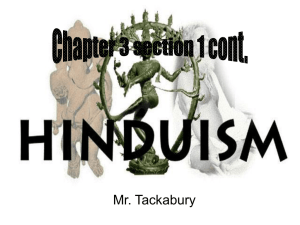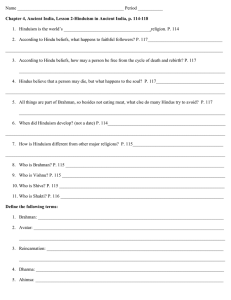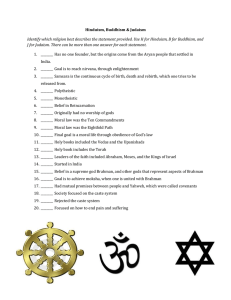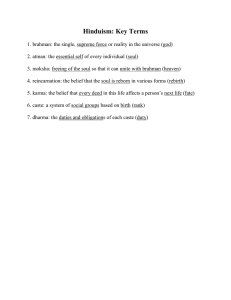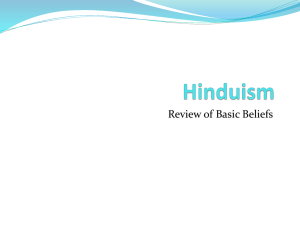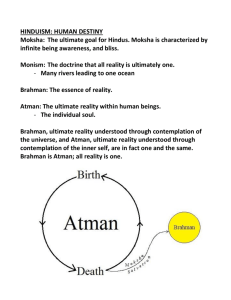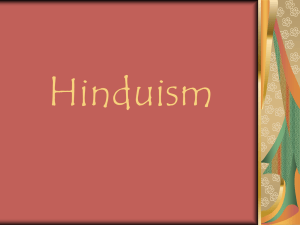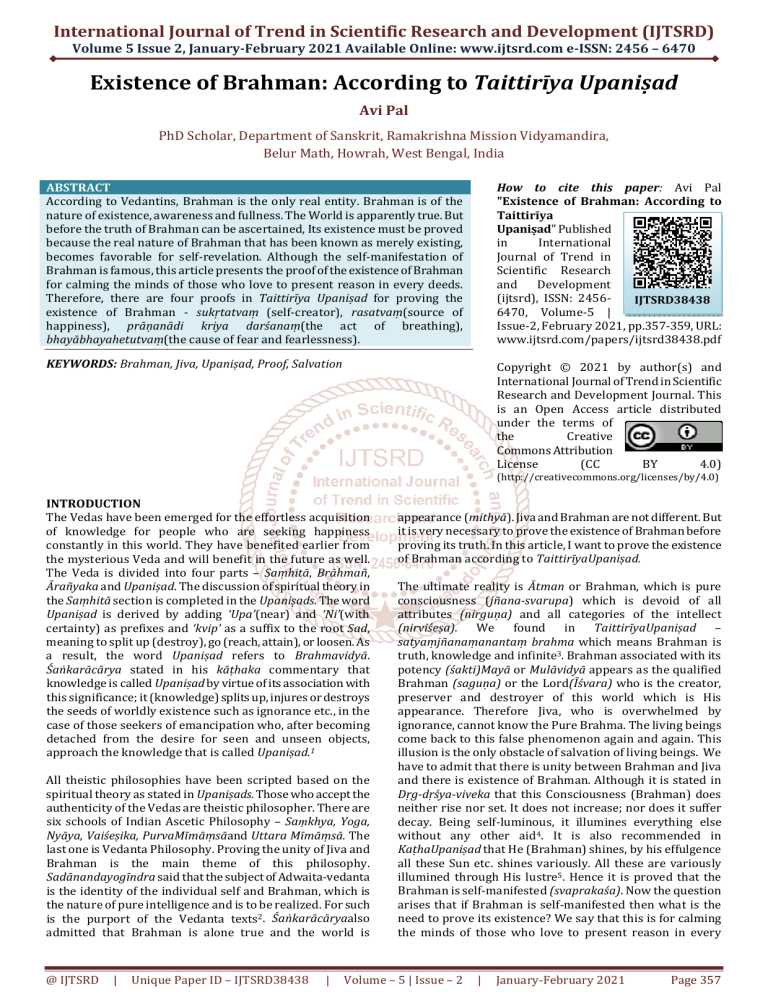
International Journal of Trend in Scientific Research and Development (IJTSRD) Volume 5 Issue 2, January-February 2021 Available Online: www.ijtsrd.com e-ISSN: 2456 – 6470 Existence of Brahman: According to Taittirīya Upaniṣad Avi Pal PhD Scholar, Department of Sanskrit, Ramakrishna Mission Vidyamandira, Belur Math, Howrah, West Bengal, India ABSTRACT According to Vedantins, Brahman is the only real entity. Brahman is of the nature of existence, awareness and fullness. The World is apparently true. But before the truth of Brahman can be ascertained, Its existence must be proved because the real nature of Brahman that has been known as merely existing, becomes favorable for self-revelation. Although the self-manifestation of Brahman is famous, this article presents the proof of the existence of Brahman for calming the minds of those who love to present reason in every deeds. Therefore, there are four proofs in Taittirīya Upaniṣad for proving the existence of Brahman - sukṛtatvaṃ (self-creator), rasatvaṃ(source of happiness), prāṇanādi kriya darśanaṃ(the act of breathing), bhayābhayahetutvaṃ(the cause of fear and fearlessness). How to cite this paper: Avi Pal "Existence of Brahman: According to Taittirīya Upaniṣad" Published in International Journal of Trend in Scientific Research and Development (ijtsrd), ISSN: 2456IJTSRD38438 6470, Volume-5 | Issue-2, February 2021, pp.357-359, URL: www.ijtsrd.com/papers/ijtsrd38438.pdf KEYWORDS: Brahman, Jiva, Upaniṣad, Proof, Salvation Copyright © 2021 by author(s) and International Journal of Trend in Scientific Research and Development Journal. This is an Open Access article distributed under the terms of the Creative Commons Attribution License (CC BY 4.0) (http://creativecommons.org/licenses/by/4.0) INTRODUCTION The Vedas have been emerged for the effortless acquisition of knowledge for people who are seeking happiness constantly in this world. They have benefited earlier from the mysterious Veda and will benefit in the future as well. The Veda is divided into four parts – Saṃhitā, Brāhmañ, Ārañyaka and Upaniṣad. The discussion of spiritual theory in the Saṃhitā section is completed in the Upaniṣads. The word Upaniṣad is derived by adding ‘Upa’(near) and ‘Ni’(with certainty) as prefixes and ‘kvip’ as a suffix to the root Sad, meaning to split up (destroy), go (reach, attain), or loosen. As a result, the word Upaniṣad refers to Brahmavidyā. Śaṅkarācārya stated in his kāṭhaka commentary that knowledge is called Upaniṣad by virtue of its association with this significance; it (knowledge) splits up, injures or destroys the seeds of worldly existence such as ignorance etc., in the case of those seekers of emancipation who, after becoming detached from the desire for seen and unseen objects, approach the knowledge that is called Upaniṣad.1 All theistic philosophies have been scripted based on the spiritual theory as stated in Upaniṣads. Those who accept the authenticity of the Vedas are theistic philosopher. There are six schools of Indian Ascetic Philosophy – Saṃkhya, Yoga, Nyāya, Vaiśeṣika, PurvaMīmāṃsāand Uttara Mīmāṃsā. The last one is Vedanta Philosophy. Proving the unity of Jiva and Brahman is the main theme of this philosophy. Sadānandayogīndra said that the subject of Adwaita-vedanta is the identity of the individual self and Brahman, which is the nature of pure intelligence and is to be realized. For such is the purport of the Vedanta texts2. Śaṅkarācāryaalso admitted that Brahman is alone true and the world is @ IJTSRD | Unique Paper ID – IJTSRD38438 | appearance (mithyā). Jiva and Brahman are not different. But it is very necessary to prove the existence of Brahman before proving its truth. In this article, I want to prove the existence of Brahman according to TaittirīyaUpaniṣad. The ultimate reality is Ātman or Brahman, which is pure consciousness (jñana-svarupa) which is devoid of all attributes (nirguṇa) and all categories of the intellect (nirviśeṣa). We found in TaittirīyaUpaniṣad – satyaṃjñanaṃanantaṃ brahma which means Brahman is truth, knowledge and infinite3. Brahman associated with its potency (śakti)Mayā or Mulāvidyā appears as the qualified Brahman (saguṇa) or the Lord(Īśvara) who is the creator, preserver and destroyer of this world which is His appearance. Therefore Jiva, who is overwhelmed by ignorance, cannot know the Pure Brahma. The living beings come back to this false phenomenon again and again. This illusion is the only obstacle of salvation of living beings. We have to admit that there is unity between Brahman and Jiva and there is existence of Brahman. Although it is stated in Dṛg-dṛśya-viveka that this Consciousness (Brahman) does neither rise nor set. It does not increase; nor does it suffer decay. Being self-luminous, it illumines everything else without any other aid4. It is also recommended in KaṭhaUpaniṣad that He (Brahman) shines, by his effulgence all these Sun etc. shines variously. All these are variously illumined through His lustre5. Hence it is proved that the Brahman is self-manifested (svaprakaśa). Now the question arises that if Brahman is self-manifested then what is the need to prove its existence? We say that this is for calming the minds of those who love to present reason in every Volume – 5 | Issue – 2 | January-February 2021 Page 357 International Journal of Trend in Scientific Research and Development (IJTSRD) @ www.ijtsrd.com eISSN: 2456-6470 deeds. There are four proofs to prove the existence of Brahman in TaittirīyaUpaniṣad – sukṛtatvaṃ (self-creator), rasatvaṃ(source of happiness), prāṇanādi kriya darśanaṃ(the act of breathing), bhayābhayahetutvaṃ(the cause of fear and fearlessness). These are explained below: Proof – I TaittirīyaUpaniṣadsays that asatvaiidamagreāsīt, in the beginning all these were but in unmanifested form6. By the word ‘asat’ is meant the unconditioned Brahman as contrasted with the state in which distinctions of name and form become manifested. Here ‘idam’ means the manifested world possessed of the distinctions of name and form. From that unconditioned Brahman, ‘sat’ which is distinguished by manifested name and form, was born. It is clear that there must be a causal relationship between Brahman and the phenomenon. Now the question arises that whether Brahman is the material (upādān) or efficient (nimitta) cause of the universe, whether Brahman has transformed himself into the world like the transformation of milk into curd or whether He has created the world like Kumbhakār making his pot. If Brahman is the material cause of this universe, it would be a conscious entity because the effect and cause are same in that case. Therefore, the universe would not be unreal. Further, Brahman cannot be the efficient cause. In that case, Brahman would be quite different from his creation as the potter is from the pot he makes. But there is śrutiwhich contradicts this view.‘tat sṛṣtvātadevānuprāviśat’ – having projected it, He entered into it. This śrutitells that Brahman after creating this world, entered into it. But these arguments are thus nullified: when Brahman associated with the Māyā, looked upon from the standpoint of His consciousness-aspect, is the efficient cause, and when looked upon from His upādhi-aspect, is the material cause of this world. It can be thus explained - Inert iron filings, when placed near a magnet, show movement. Similarly, ignorance which is inert and lifeless shows activity owing to the proximity of Brahman. Therefore, Brahman is instrumental to the activity and manifestation of Māyā. Again, Māyāis the direct material cause of the universe, and therefore Iśvara also, who is the lord of Māyā, is indirectly said to be the material cause of the world. Again, Vedantin applies the law of Vivarta in explaining creation which means the transformation of the cause into effect without the former losing its character, hence, apparent transformation. The world is the Vivarta of Brahman. The whole universe is a mere illusion – an unreal and illusory appearance –while Brahman is the only real entity. Therefore, if Brahman is posited as the material cause of the universe, it does not follow that the universe is also a conscious entity like its cause. Thus, unconditioned Brahman created this universe itself and He is well recognized in this world as self-creator (sukṛta). That universal recognition is possible only if there is an eternal consciousness acting as the cause. hence, from the universal fact of admission of sukṛta, it follows that Brahman exists. Proof – II TaittirīyaUpaniṣadsays the second proof for the existence of Brahman – rasovaisaḥ7. It means that He (Brahman) is the source of joy (rasaḥ). Rasaḥstands for anything that is a mean for satisfaction, a source of joy, such as sweet and sour things, which are well known in this world. Although Brahman’s indivisibility, essence and form of knowledge are famous, still no observer wants to know the nature of @ IJTSRD | Unique Paper ID – IJTSRD38438 | Brahman without Its happiness. Therefore, Brahman is also ensured as a form of bliss. But there is no reason to think that this view-point contradicts theśruti passage – aśarīraṃvāvasantaṃpriyāpriyenaspṛśataḥ, neither pleasure nor pain touches one who is not identified with body8. Actually, this passage speaks of worldly happiness but in this case of rasaḥ, we are talking about eternal joy. Hence, there is no such contradiction. But it must be remembered that here the word rasaḥ does not mean rasavat, which means having happiness. Here rasaḥ indicates that It (Brahman) is happiness itself. Swami Vivekananda said that – “It cannot be that the soul has existence but it is existence. It cannot be that the soul is happy; it is happiness itself. That which is happy has borrowed its happiness; that which has knowledge has received its knowledge and that which has relative existence has only a reflected existence.9” We see that one becomes happy getting a thing of joy and becomes unhappy no to get it. We also find that the sages who, having realised the Brahman, are filled with joy. They do not possess any worldly objects of pleasure, such as flowers, women etc. they do not take help of any external means of happiness, make no effort and cherish no desire, but still they are seen to be as happy as one is from obtaining an external source of joy. Therefore, we should admit that Brahman does exist as the bliss which is the source of happiness of the sages. Proof – III The existence of Brahman can be determined by wise people by the proof of bliss, but it is impossible for the common man. This is why TaittirīyaUpaniṣadexpresses the additional reason – Brahman exists as the source of our physical activity and sensual pleasure. The śruti proceeds – ko hyevānyatkaḥpraṇyat / yadeṣaākāśaānandonasyāt / eṣahyevā”nandayāti10. It means that who indeed will inhale, and who will exhale if the bliss be not there in the supreme space (with in heart). This one, indeed enlivens (people). It is observed that all composite products are for the sake of another’s use – like bedsteads, chairs and other aggregates exist only for the use of the body. Just like that, such actions as exhaling and inhaling are found in aggregated form. Thus, we can decide that these deeds are for the sake of another’s use. This achievement of unity for serving a common purpose is not possible unless there is an intelligence which is not a part of this combination. For such is not the case anywhere else. The śruti says that if in the Supreme Ether, in the cave of the heart, this one does not exist, who indeed in the world could breathe in and who could breathe up? Therefore, there exists that one Brahman. People’s happiness is caused by that very entity for whose purpose there are such activities of the body and senses. It is stated in KaṭhaUpaniṣad that no mortal lives by prāñaor apāna; but all live by something else on which these two depend. Saṇghataparārthatva (the aggregate is for another’s sake) has also been cited as a proof of determining the existence of puruṣa in Sāṃkhya Philosophy. The same thought has been expressed in Kenoponiṣad–keneṣitaṃpatatipreṣitaṃmanaḥ kenaprāñaḥprathamaḥpraitiyuktaḥ. / keneṣitaṃvācamimāṃvadanti / cakṣuḥśrotraṃ ka u devo yunakti11. Volume – 5 | Issue – 2 | January-February 2021 Page 358 International Journal of Trend in Scientific Research and Development (IJTSRD) @ www.ijtsrd.com eISSN: 2456-6470 So, it is impossible to continue the act of breathing for an object which is unaffected by Brahman. We can assume that Brahman exists due to the respiration of living beings, who are possessed by Brahman. established in the mind of an aspirant because astīthyevopalabdhasya tattva-bhabāḥprasīdati17, when Brahman is to be realised as existence, His real nature becomes clear. Proof – IV The fourth and final proof for proving the existence of Brahman is bhayābhayahetutvaṃ, the cause of fear and fearlessness. In this case, Brahman is the cause of fear for the ignorant people and it is the cause of fearlessness for the wise men. Fearlessness comes as a result of taking refuge in something that exists, whereas fear cannot cease by resorting to something that does not exist. Brahman has real entity. When one is established in this Brahman, he becomes fearless because there is no reason to be afraid. But what kind of Brahman should be established by an aspirant? Śruti says adṛśyeanātmyeanirukteanilayane. Brahman is adṛśyam, invisible. Visible (dṛśya) means what is capable of perception, a phenomenon. Every phenomenon subserves a perception. Brahman is not visible. He is not a phenomenon, no object of perception. It is said in Dṛg-dṛśya-vivekathat the form (all objects of perception) is perceived and the eye (organs of perception) is its perceiver. It (eye) is perceived and the mind is its perceiver. The mind with its modifications is perceived and the witness (the self) is verily the perceiver. But it (the witness) is not perceived (by any other)12. Again, Brahman is anātmyam, unembodied. Since it is imperceptible, it is incorporeal. Since it is incorporeal, it is aniruktam, inexpressible. It is possible to express distinguished, but it is impossible to describe undistinguished Brahman. So, it is inexpressible. Since it is aniruktam, it is anilayanam. Nilayana means shelter, anilayana is the opposite of that. When an aspirant is established in that Brahman, he becomes fearless. Although there are many reasons for fearing in this world, but as a source of fearlessness it is confirmed that Brahman exists. But one who realises Brahman as a separate entity, Brahman becomes the source of fear for them. It is stated in TaittirīyaUpaniṣadthat Wind blows out of his fear. Out of his fear the Sun rises. Out of his fear Fire runs, as also Indra, and Death, the fifth13. Hence, it is proved that Brahman exists as the source of fear and fearlessness. References [1] Eights Upanisads with the commentary of Śaṇkaracārya, (Vol - 1) translated by Swami Gambhirananda, Page– 93-94 Conclusion Brahman is self-expressed. natatracakṣuḥgacchatinavākgacchati no manaḥ- the eye does not go there, nor speech, nor mind. Thus, Brahman cannot be expressed in any way. Yet the evidence is presented here to test the essence of Brahman. But here the word ‘essence’does not denote asti, as it is stated in Nirukta14. There is also perceptual evidence for the existence of Brahman. It is said in Advaita-makaranda that: ahamasisadābhāmikadacinnāhamapriyaḥ. brahmaivāhamataḥsiddhaṃsaccidānandalakṣaṇam.15 [2] Vedantasara of Sadananda, Edited by Swami Nikhilananda, Page - 16 [3] Eights Upanisads with the commentary of Śaṇkaracārya, (Vol - 1) translated by Swami Gambhirananda, Page– 286-287 [4] Dṛg-dṛśyaViveka, Edited by Swami Nikhilananda, Page - 6 [5] Commentary of KaṭhaUpaniṣad, Edited by Swami Krishnananda, Page - 146 [6] Eights Upanisads with the commentary of Śaṇkaracārya, (Vol - 1) translated by Swami Gambhirananda, Page–341 [7] Ibid. [8] The Chhandogya Upanishad, edited by Krishnananda, Page - 317 [9] The Complete Work of Swami Vivekananda, vol – 2, Page - 216 [10] Eights Upanisads with the commentary of Śaṇkaracārya, (Vol - 1) translated by Swami Gambhirananda, Page–341 [11] By whom missioned falls the mind shot to its mark? By whom yoked does the first life-breath move forward on its paths? By whom impelled is this word that men speak? What God set eye and ear to their working? (Kenoponishad, Edited by Sri Aurobindo, Page – 1) [12] Dṛg-dṛśyaViveka, Edited by Swami Nikhilananda, Page - 2 [13] It is also said in KaṭhaUpaniśad that from fear of it, fire burns, sun shines; through fear of It, Indra, the wind and Death, the fifth, speed on their way. (2/2/3) [14] In Nirukta, the word ‘asti’ is used for a material, which is not permanent. [15] I am always be, I always shine. I am never an object of dislike to myself. Therefore, it is established that I am that Brahman which is of the nature of existence, awareness and fullness.(AdvaitaMakaranda, Edited by Ann Berliner, Page – 7) [16] In me, in the space of awareness rises the celestial city called the world. Therefore, how am I not Brahman, who is all knower and the cause of all. (AdvaitaMakaranda, Edited by Ann Berliner, Page – 13) [17] Commentary of KaṭhaUpaniṣad, Edited by Swami Krishnananda, Page - 171 mayyevodeticidvyomnijagadgandharvapattanam. ato’haṃnakathaṃ Brahma sarvajñaṃsarvakāraṇam.16 The existence of Brahman can also be assumed from general perspective. Brahman is full of excellence. Wherever we see excellence, we have to admit that there is a vibration of Brahman. The thought of the existence of Brahman must be @ IJTSRD | Unique Paper ID – IJTSRD38438 | Volume – 5 | Issue – 2 | January-February 2021 Page 359
